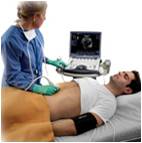
Ultrasound
What Is Ultrasound?
PPX provides ultrasound services in select areas. Please contact PPX to learn if mobile ultrasound exams are available in your area. Ultrasound is a simple, safe and effective procedure that helps diagnose many medical conditions. It uses sound waves to produce a picture of organs and other structures inside the body. There are no known side effects and the procedure does not require any special dyes or radiation. An echocardiogram is an ultrasound procedure of your heart. During an ultrasound, a sonographer passes a small handheld instrument called a transducer back and forth over the area of your body being examined. The transducer emits and detects sound wave frequencies too high for us to hear. As the sound waves penetrate the body, they are reflected back by its structures. A computer analyzes the sound waves that are reflected by structures in your body and converts them into a picture that is displayed on a video monitor.
Is it Safe?
Sound waves do not cause pain and there are no confirmed adverse effects. There is no radiation used during an ultrasound examination.
Why is Ultrasound Used?
Ultrasound can help detect, diagnose or monitor many conditions. The following is a general indication of the types of conditions ultrasound is used to detect and is not meant to be all-inclusive.
What Can I Expect?
A standard ultrasound exam is simple. A sonographer will gather basic information from you, then position you on an exam table. A gel or liquid will be applied to the skin over the area being examined to improve the quality of the images. A transducer (wand-type instrument) will be passed over the area several times. Depending on your exam, you might be asked to remain still, change positions, hold your breath or do simple breathing exercises. After the procedure, the sonographer will remove the gel from your skin.
Most exams take 30-60 minutes. There is no pain involved, but you might feel mild pressure from the transducer, some discomfort from lying or sitting in certain positions, or some discomfort from having a full bladder.
How Do I Prepare?
- Dress comfortably. You might be given a hospital gown and asked to undress from the waist up or the waist down.
- Fill or empty your bladder. While some ultrasounds, such as transvaginal ultrasound, work best when the bladder is empty, others work better with a full bladder. Follow your physician's instructions.
- For pelvic or obstetrical exams, finish drinking six glasses of liquid one hour prior to the beginning of your exam. Do not empty your bladder until the exam is completed.
- Eat or drink according to your physician's instructions. Since ultrasound does not pass through gases, you might have to fast for several hours to eliminate gas for abdominal exams. Other exams have no restrictions.
- For abdominal exams, do not chew gum, eat or drink after midnight the day before your exam. Avoid gas-producing food or drinks.
- Other recommendations. You might be told not to wear lotions, powder or deodorants. If you smoke, you might be required to not do so for a certain amount of time.
How Do I Get The Results?
Your exam results will be sent to your physician, who will discuss them with you.
If you have any questions or comments about your ultrasound at any time, please talk to your physician or inform the sonographer. We want to make you as comfortable with the exam as possible.














